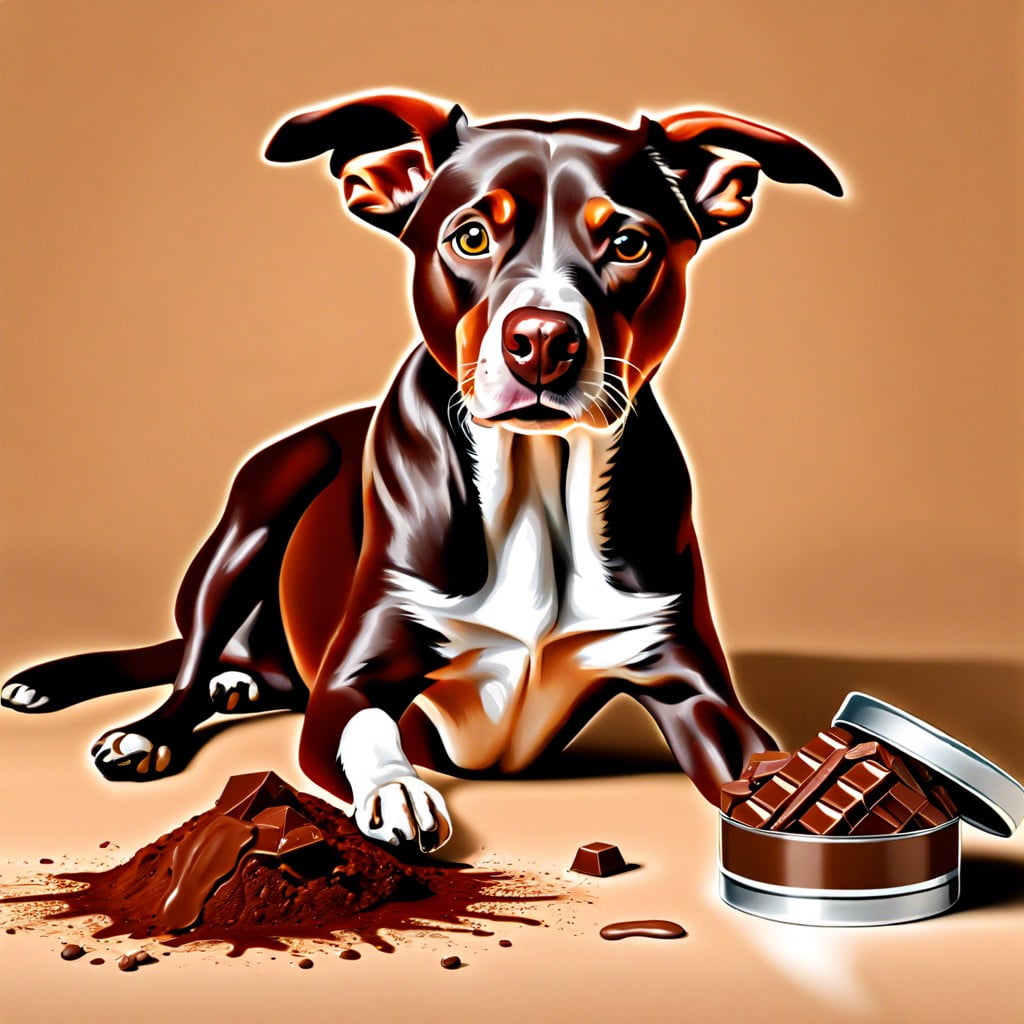This article provides crucial information on the lethal dose of chocolate for dogs, offering a better understanding of this often underestimated danger.
Key takeaways:
- Chocolate contains toxic compounds for dogs, theobromine and caffeine.
- The smaller the dog, the less chocolate it takes to be toxic.
- Milk chocolate is less toxic than dark chocolate, but still dangerous.
- White chocolate has negligible theobromine levels but is still unhealthy.
- Approximately 100-200 mg of theobromine per kg of a dog’s body weight can be lethal.
Inside
The Toxic Dose of Chocolate for Dogs

Chocolate contains theobromine and caffeine, which are toxic to dogs in sufficient quantities. The lethal dose varies depending mainly on a dog’s size and the chocolate’s theobromine content.
The smaller the dog, the less theobromine it takes to become toxic. For example, just an ounce of dark chocolate may be lethal for a small dog.
Milk chocolate has less theobromine than dark chocolate, but it is still dangerous because dogs may easily ingest large quantities.
White chocolate has negligible theobromine levels but is still unhealthy due to fats and sugars.
Approximately 100-200 mg of theobromine per kilogram of the dog’s body weight can be lethal.
To estimate a toxic dose, consider that milk chocolate contains about 44 mg of theobromine per ounce, semisweet chocolate contains about 150 mg per ounce, and baking chocolate contains about 390 mg per ounce.
Factors like the dog’s individual sensitivity and pre-existing health conditions also play a role in the potential danger level. Always err on the side of caution and keep chocolate out of reach. If ingestion does occur, consult a veterinarian immediately.
Identifying Different Types of Chocolate and Their Toxicity Levels
Different chocolates contain varying levels of theobromine, the compound harmful to dogs. Here’s how they rank by toxicity:
- Cocoa powder (most toxic)
- Unsweetened baker’s chocolate
- Semisweet chocolate
- Dark chocolate
- Milk chocolate (least toxic)
White chocolate contains negligible amounts of theobromine, but it’s still unhealthy for dogs due to fat and sugar content. The darker and more concentrated the chocolate, the more dangerous it is to your pet. Always check the cocoa percentage on chocolate products to gauge their potential toxicity.
Immediate Actions to Take If a Dog Consumes Chocolate
If your dog eats chocolate:
- Stay calm and assess the situation—note the type and amount of chocolate ingested.
- Remove any remaining chocolate from the dog’s reach to prevent further ingestion.
- Check for symptoms such as restlessness, increased heart rate, vomiting, or diarrhea.
- Contact your veterinarian or a pet poison hotline immediately for advice.
- Do not induce vomiting unless instructed by a professional.
- Gather information on your dog’s size, the chocolate type, and the quantity consumed to tell the vet.
- Be ready to provide your dog’s medical history during the consultation.
- Follow the veterinarian’s instructions, which may include bringing your dog in for an examination.
- Keep emergency contact numbers for your veterinarian or pet poison control easily accessible at all times.
Symptoms of Chocolate Poisoning in Dogs
Dogs that have ingested chocolate may display a range of symptoms, which usually occur within 6 to 12 hours post-consumption. Here are the signs pet owners should watch for:
- Hyperactivity: A sudden increase in energy or restlessness may be noticed due to the stimulating effects of theobromine, a compound found in chocolate.
- Vomiting and Diarrhea: The body’s attempt to expel the toxin can result in these gastrointestinal symptoms.
- Increased Thirst and Urination: Theobromine causes increased heart rate and the urge to urinate more frequently.
- Rapid Breathing: As the heart rate elevates, so does a dog’s need for oxygen, which may manifest as panting or rapid breathing.
- Seizures: In severe cases of toxicity, dogs may experience muscle tremors or seizures.
- Weakness and Collapse: If left untreated, the dog may become weak or even experience cardiac arrest, leading to collapse.
Monitoring a dog closely and seeking immediate veterinary care upon noticing these symptoms is essential for their health and safety.
Preventive Measures to Protect Dogs From Chocolate
Store chocolate out of reach, ensuring it’s inaccessible to your dog. Use high shelves or closed cabinets that can’t be easily opened by curious paws.
Educate everyone in the household about the dangers of chocolate to dogs. Ensure children understand the importance of keeping chocolate away from pets.
Be cautious during holidays like Easter and Halloween when chocolate tends to be more abundant at home. Keep all chocolate treats and candy bags secured.
Consider dog-safe chocolate alternatives for pet-friendly celebrations. These are made with carob, which mimics the flavor of chocolate without containing theobromine.
Supervise your dog in unknown environments where chocolate might be within reach, such as parties or outdoor events.
Talk to dog sitters and house guests about the chocolate rule. Make it clear that they must not feed your dog chocolate or leave it within reach.
Be vigilant with chocolate-flavored wrappers, containers, and baking supplies. Dogs may be attracted to the residue and could ingest harmful amounts. Dispose of these items securely.




